Hod HaSharon
| Hod HaSharon | ||
|---|---|---|
| Hebrew transcription(s) | ||
| • Hebrew | הוֹד הַשָּׁרוֹן | |
| • ISO 259 | Hod ha Šaron | |
| Arabic transcription(s) | ||
| • Arabic | هود هاشرون | |
 | ||
| ||
 Hod HaSharon | ||
| Coordinates: 32°09′N 34°53′E / 32.150°N 34.883°ECoordinates: 32°09′N 34°53′E / 32.150°N 34.883°E | ||
| District | Center | |
| Founded | 1964 | |
| Government | ||
| • Type | City (from 1990) | |
| • Mayor | Hai Adiv | |
| Area | ||
| • Total | 19,239 dunams (19.239 km2 or 7.428 sq mi) | |
| Population (2007) | ||
| • Total | 45,700 | |
| Name meaning | Splendor of the Sharon plain | |
Hod HaSharon (Hebrew: הוֹד הַשָּׁרוֹן, lit. "Splendor of the Sharon") is a city in the Center District of Israel.
Officially declared a city in 1990, Hod HaSharon was created from the union in 1964 of four neighboring villages: Magdiel, Ramatayim, Hadar, and Ramat Hadar.[1] Its official land area is 19.239 square kilometres (7.428 sq mi),[2] and according to the Israel Central Bureau of Statistics (CBS), in December 2007 the city had a total population of 45,700.[3]
History
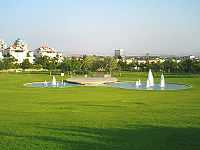
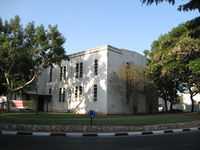
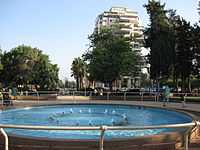
Hod HaSharon was created in 1964 when the settlements of Magdiel, Ramatayim, Hadar, and Ramat Hadar merged. Hod Hasharon was governed by a local council until it was declared a city in 1990.[4]
Magdiel
Magdiel was founded on August 2, 1924. The decision to establish Magdiel was reached at a founders meeting in Tel Aviv in July. A group of 12 settlers of Ashkenazi origin received a plot of land from Yehoshua Hankin which they cultivated and prepared for farming.[4]
Ramatayim
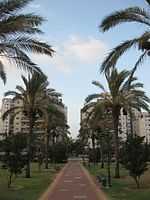
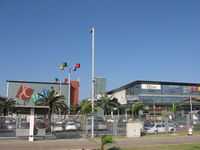
Ramatayim was founded in 1925 by immigrants from Poland.[1] It was founded on the principle of private initiative. Ramatayim was built on two hills connected by a valley, hence the name Ramatayim, literally 'two hills'.[4] Ramatayim is now the center of Hod HaSharon.
Hadar
Hadar was established in 1927 by middle-class immigrants from Eastern Europe, who were joined soon after by a group of Italian Jews.[1] The land was purchased from the Abou Kishk Bedouin tribe. The pioneers decided to build a rural settlement based on citrus crops (hence the village's name, "Hadar" being Hebrew for "citrus"). In its early years, the farmers of Hadar also engaged in poultry farming. In the early 1940s, Yemenite immigrants moved to Hadar, establishing the Shikun Hateymanim quarter, today part of the Gannei Tzvi neighborhood.[4] In 1951, Ramatayim and Hadar merged to form Hadar Ramatayim.[1]
Ramat Hadar
Ramat Hadar was established in December 1938 by middle-class immigrants from Germany, members of the Fifth Aliyah.[1] Ramat Hadar was built on a hill between Kfar Hadar, Ramatayim, and the main road from Petah Tikva to Ramatayim. The economy of Ramat Hadar was based on small farms, mainly poultry farming.[4]
Geography
Hod HaSharon is located on central Israel's Sharon Plain, part of the Israeli Coastal Plain. The city is located approximately 10 kilometres (6.2 mi) east of the Mediterranean coastline, south of Kfar Saba, southeast of Raanana, and northeast of Ramat HaSharon. The city is approximately 8 kilometres (5.0 mi) west of the West Bank and 8 kilometres (5.0 mi) northeast of central Tel Aviv.
Demographics
According to the CBS, the ethnic makeup of the city was in 2006 was 99.9% Jewish and other non-Arab, with no significant Arab population. In 2006 77 immigrants from out of Israel settled in Hod HaSharon as their first place of residence in the country, of whom 68.8% were under 18 years of age. 6.8% of the population of the city consists of immigrants to Israel since 1990. By 2025, the city is planned to have 80,000 inhabitants. The population density of Hod HaSharon is the lowest in the Sharon Plain.[4]
According to the CBS, in 2006 there were 21,700 males and 22,800 females. The population of the city was spread out with 33.2% 19 years of age or younger, 13.0% between 20 and 29, 23.2% between 30 and 44, 18.5% from 45 to 59, 3.6% from 60 to 64, and 8.6% 65 years of age or older. The population growth rate in 2006 was 3.3%.[2]
According to the CBS, as of 2005, there were 18,612 salaried workers and 2,006 are self-employed in the city. The mean monthly wage in 2004 for a salaried worker in the city was ILS 9,698, a year-on-year increase of 7.1%. Salaried males had a mean monthly wage of ILS 13,326 (a real change of 9.5%) versus ILS 6,306 for females (a real change of 1.6%). The mean income for the self-employed is ILS 8,490. There are 335 people who receive unemployment benefits and 300 people who receive an income guarantee.[2]
Education
According to the CBS, there are 18 schools and 8,083 students in the city: 11 elementary schools: The Democratic School, HaMagen, Yigal Alon, Lapid, Shilo, Mamlachti Alef, Neve Ne'eman, Rabin, Re'ut and Tali (4,406 students). 4 middle schools: HaRishonim, HaShachar, Atidim and Tzurim (1,628 students). 5 high schools: Hadarim, Alexander Muss Institute for Israel Education, Ramon, Mossinzohn and Na'amat (2,049 students). 71.7% of the city's 12th graders were entitled to a matriculation certificate in 2001.[2]
The Mosenson youth village accepts both Israelis and overseas students.[5] The Alexander Muss High School in Israel offers a program for American high school students who spend two months to a year in Israel. Each year approximately half of the tenth grade class from the Milken Community High School in Los Angeles, CA, come to Hod Hasharon to study for a semester along with this program.
Twin towns — Sister cities
Hod HaSharon is twinned with:
Notable residents
- Ron Arad (b. 1958), Israeli Air Force weapon systems officer; classified as missing in action since 1986
- Danny Ayalon (b. 1955), politician and former ambassador
- Dor Daniel (b. 1982), singer-songwriter
- Gedalia Gal (b. 1933), farmer and former politician and member of the Israeli Knesset
- Keren Hadar, soprano singer
- Yifat Kariv (b. 1973), member of the Israeli Knesset and social worker
- Keren Leibovitch (b. 1973), champion Paralympic swimmer
- Yaniv Luzon (b. 1981), footballer
- Bar Refaeli (b. 1985), model and actress
- Ehud "Udi" Tenenbaum (b. 1979), cracker, also known as The Analyzer
- Avihai Yadin (b. 1986), footballer
External links
- Official municipal website (Hebrew)
- Official Youth Council website (Hebrew)
References
- ↑ 1.0 1.1 1.2 1.3 1.4 Encyclopedia Judaica, Keter Publishing House, Jerusalem, 1972, Vol. 8, p. 802, "Hod Ha-Sharon"
- ↑ 2.0 2.1 2.2 2.3 "Local Authorities in Israel 2006, Publication #1315 - Municipality Profiles - Hod HaSharon". Israel Central Bureau of Statistics. 2006. Retrieved 2008-10-21. (Hebrew)
- ↑ "Table 3 - Population of Localities Numbering Above 1,000 Residents and Other Rural Population". Israel Central Bureau of Statistics. 2008-06-30. Retrieved 2008-10-18.
- ↑ 4.0 4.1 4.2 4.3 4.4 4.5 "Identiy Card". Retrieved 2008-04-07.
- ↑ Mosenson youth village
- ↑ "List of Twin Towns in the Ruhr Destrict". © 2009 Twins2010.com. Retrieved 2009-10-28.
| Wikimedia Commons has media related to Hod Hasharon. |
| |||||||||||||||||||||||
